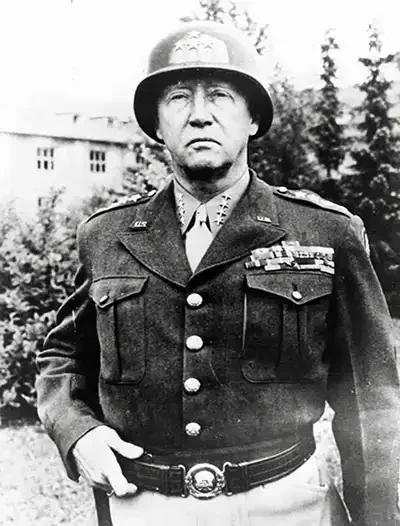- Military History
- Biographies
- Militarians Biographies
- General George S. Patton
General George S. Patton
An outstanding expert of mobile tank warfare during World War II, however, his brash actions and volatile temper led to many controversies during his career
Born in San Gabriel, California, George S. Patton, Jr., was the grandson of Confederate military leaders. He attended the Virginia Military Institute before going to the U.S. Military Academy at West Point. He graduated in 1909 and was commissioned as a cavalry lieutenant.
Patton's first chance to get recognition came when he served as aide to General John Pershing in the chase after Mexican revolutionary Pancho Villa. George S. Patton cornered and killed one of Villa's subordinates. Patton went with Pershing to Europe in 1917 and served as the commanding officer of the general's headquarters. He also was one of the first officers named to enter the new tanks corps created late in World War I.
Patton was wounded in the Meuse-Argonne offensive (1918). As World War II approached, he was promoted to two-star general (1941). Patton was given command of the First Armored Corps. He played a prominent role in the Allied landings in North Africa in 1942. After the Battle of Kasserine Pass, he was made commander of the Second Armored Corps. Ordered to find a solution to the mobile warfare practiced by German general Erwin Rommel, Patton became a practitioner of the same art.
He led the Allied invasion that cleared the Germans from Sicily in thirty-eight days, and he was near the height of his career when he brought criticism to himself after he slapped a U.S. soldier in a hospital. The man was recovering from shell shock. Patton claimed the soldier was malingering but later issued an apology for his action.
Patton became commander of the Third Army in England (March 1944). He landed with his men at Normandy and led the famous "breakout" that equaled any of the German blitzkrieg campaigns in its audacity. Patton led his tanks and troops all the way to Nancy and Metz, bypassing Paris, before running out of gas and supplies. During the Battle of the Bulge (December 1944), Patton raced northward with the Third Army, relieved the key city of Bastogne, and doomed the German offensive.
Patton's troops crossed the Rhine River in March 1945, and he entered Czechoslovakia by the time the war ended. Named military governor of Bavaria, Patton proved completely unsuited to such an administrative post. He openly preferred the Germans to the Soviets and hinted he would like to campaign against Russia in the future. Because of these intemperate statements, Patton was removed from command of the Third Army that October.
Patton died in Heidelberg, Germany, after an auto accident later that year.
General George S. Patton - Quick Facts
- 15th Army (United States 1944-1946)
- 2nd Armored Division (United States 1940-1995)
- 304th Tank Brigade (United States)
- 3rd Armored Division (United States)
- 5th Cavalry Regiment (United States)
- 7th Army (United States)
- I Armored Corps (United States)
- II Corps (United States)
- United States Army
- WWI (1914-1918)
- WWII (1939-1945)
- {{#owner}}
- {{#url}} {{#avatarSrc}}
{{name}} {{/url}} {{^url}} {{#avatar}} {{& avatar}} {{/avatar}} {{name}} {{/url}} - {{/owner}} {{#created}}
- {{created}} {{/created}}
























